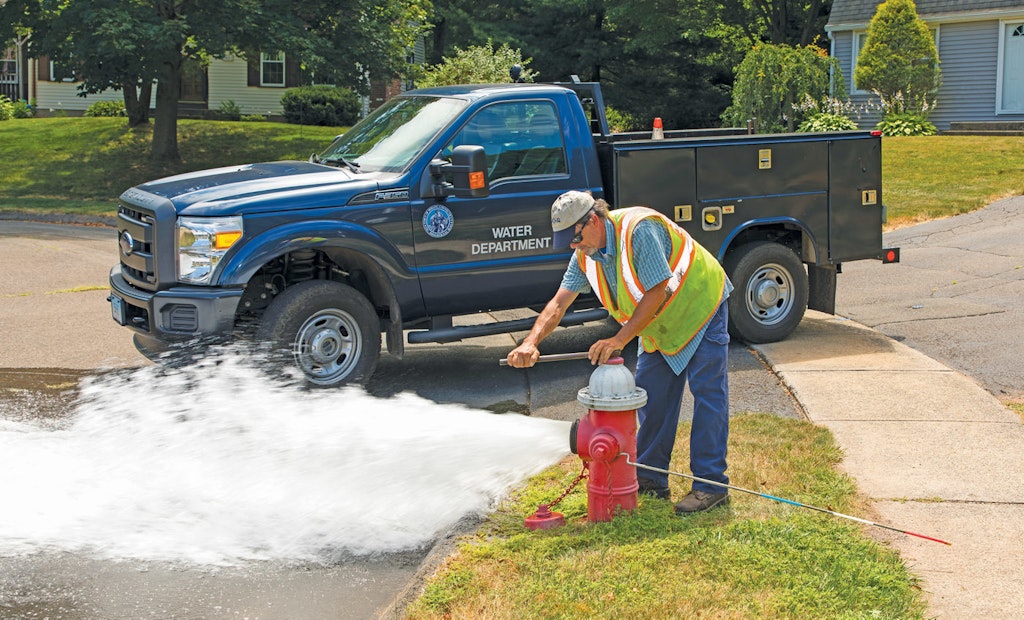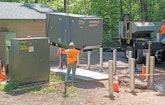
Crew member Bill Dornfried with the Berlin (Connecticut) Water Control Commission flushes a hydrant at the dead end of a local street. (Photography by John Marinelli)
Ask about the source of the water delivered by the Berlin (Connecticut) Water Control Commission and the answer you get might be summarized by the classic option found on a multiple choice exam: D) All of the above.
With 2,700 of its own customers as well as another 1,000 customers in the Worthington Fire District, the BWCC operates a system that relies upon its own wellfield as well as pretreated water from several neighbors that draw water from reservoirs and aquifers in a closely managed network that bridges municipal and service area boundaries in southern Connecticut.
Ray Jarema, water control manager at the BWCC, says the two active wells in the town’s Elton wellfield could meet nearly all of the daily demands of the system’s customers, but the water utility instead purchases close to half of its water from two neighboring systems in order to better manage its resources.
Multiple sources
In 2018, BWCC produced about 57% (approximately 203.7 million gallons) of its water while purchasing about 39% from the New Britain Water Department and 4% from the Cromwell Fire District. The BWCC also has a connection with the Metropolitan District Commission, a regional utility providing water and wastewater services for more than a dozen cities and towns in the Hartford area.
And while the Metropolitan District Commission brings a large part of the Hartford region under one umbrella for water and sewer services, in the town of Berlin the BWCC is just one of three agencies serving the public. In addition to his own employer, Jarema says, there are two fire districts that have historically served as the water suppliers for parts of the town.
“Worthington and Kensington are fiercely independent,” Jarema says. Although they were originally formed to organize fire protection services in rural Connecticut, over the years many fire districts were granted legislative franchises to operate utility systems, as well. Today, Worthington contracts with BWCC to handle all of its water supply needs and Kensington contracts directly with New Britain.
The BWCC looks to its larger neighbors to contract the production of a large share of its water, with the New Britain water coming from a reservoir and treatment plant on the border between the two towns that are considered outlying suburbs of Hartford.
On top of that, BWCC is in the process of establishing a potential physical connection with the Meriden Water Division to the south. Jarema says this arrangement is being considered with an eye to the future as denser development moves toward the Berlin area.
In addition to serving the water needs of a large part of the town of Berlin, the BWCC also provides wastewater collection services for the entire town. Although many property owners still use onsite septic systems for their waste-water, Jarema’s department oversees 37 miles of sewer lines and 10 pumping stations that collect approximately 1 billion gallons of wastewater per year and delivers it to the Mattabassett District Water Pollution Control Facility. That treatment plant processes wastewater from New Britain, Berlin, Cromwell, Middletown, Newington, Rocky Hill and Farmington before discharging treated effluent into the Connecticut River.
The BWCC system
For its water customers, the BWCC currently has two pumps in use as well as chlorination and fluoridation equipment at the wellfield, 47 miles of water mains and a 2 million-gallon storage tank.
The commission’s own production comes from two gravel-packed wells each rated at 350 gpm but operating at levels below that rate. “We can produce up to 1 mgd if we want to,” Jarema says. “But we generally run lower than that.”
Elton Well No. 2A is 95 feet and went into service in 1996. It was rehabilitated and resurged in 2017. Elton Well No. 1B replaced Well No. 1A in 2017. Although the BWCC had some concerns about the contamination of its groundwater in the 1970s, it was able to manage the situation and continues to do so now.
Early in the use of the Elton wellfield, tests came back showing one well contaminated with trichloroethylene. Jarema says that because the contamination was found in just one of two wells and because the levels of the chemical have steadily decreased, “We know it was a one-shot contamination.”
He says the trichloroethylene levels have always tested lower than the limits set by state and federal regulators. Even though he has managed BWCC for five years, Jarema is fully aware of the utility’s track record on managing the situation because for much of his 40-year career with the state, he was the chief engineer of the drinking water division of the Connecticut Department of Health.
In 2017, when BWCC replaced one well and resurged another, Jarema says he and his staff watched closely to make sure tests didn’t show any new problems. Before the updates, he says, “We had a perfect blend (between the new wells and the purchased water). Qualitywise it was coming out the way I wanted it.”
After the wells went back online in 2017, the test results were even better. “We had been well below standards, but coming out of the Health Department, I thought it was better to get it down to nondetect,” Jarema says. “The two wells are always used together, and the resultant blend is nondetectable, our goal.”
And that is where the numbers now stand, with trichloroethylene readings averaging 0.0009 mg/L, far below the Environmental Protection Agency standard of 0.005 mg/L.
Benefits of blending
In addition to blending the well water, Jarema says the careful blending of that water with the treated water purchased from other systems gives BWCC customers the best possible combination of quality and costs. He says the approach also helps the town in its long-term planning because it makes use of the most accessible water supplies while giving the system the capacity to accommodate growing demand as more people build homes in the semirural areas of town.
Adding the new connections with the Metropolitan District Commission and Meriden Water Department gives the BWCC a buffer against any potential future setbacks with its own groundwater supplies. If the town’s aquifer were to be somehow tainted by chemicals or other pollutants, the new connections will give Jarema the ability to quickly secure bulk water supplies and maintain service to BWCC customers without interruption.
The backup connections can also be important when production slows in either of the BWCC wells due to siltation in the gravel pack that holds back the fine sand and silt that might denigrate water quality. Jarema says that when flows do slow on a commission well, his crew is often able to restore production by resurging that well with reverse pressure. But after several such procedures, the renewed flow rates are no longer sufficient and the commission then drills a new well. Because of the permitting, labor and testing required to establish a new well, BWCC’s production capacity can fall off for months, making the interconnectivity with other water utilities an important asset.
To operate both the water system and the collections system, Jarema has a staff of four full-time operators. He says all of the operators have dual state certification in both water treatment and water distribution, affording him the maximum flexibility in assigning staff as needs arise.
A rookie once more
Just a glance at Ray Jarema’s resume will tell you that he is a longtime professional in the drinking water industry, but in some ways the water production manager at the Berlin (Connecticut) Water Control Commission is a rookie learning a new role on the job.
Jarema was a state regulator for 40 years, serving as the chief engineer of the drinking water division at the Connecticut Department of Health. It was his job to oversee testing and regulation of water utilities throughout the state, including the water system located just 2 miles from his home.
After retiring from the state, Jarema planned to launch a consulting firm before he learned the BWCC was seeking a new manager. He applied for the job and was hired five years ago on a half-time basis. Jarema says he was confident about taking the new job because “I regulated this utility for years.”
Although he is pleased with the transition to his new role, Jarema says it has been challenging because he not only has to keep an eye on water quality, but on many other issues from pipeline maintenance, equipment purchases and personnel to long-term planning. “It’s very hands-on. It’s operational, but it’s also financial.”
Now when a problem arises, the civil engineer has to consider a number of concerns including the oversight of the eight-member board that governs the utility. He needs to be ready to answer board members’ concerns, explain his decisions and help them steer the future of the town’s water supply. He also needs to be able to operate the utility under a budget approved by the board.
Even when wells are flowing as expected, water quality is high, and the distribution system is functioning well, Jarema has learned that he needs to keep an eye on things in order to keep the system on an even keel. He spends much of his time planning for new connections, the relining of aging waterlines, replacing key mechanical equipment, and the operation of the commission’s sewage collections system, which also falls under his purview.








